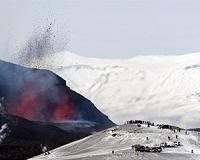| . |  |
. |
Paris (AFP) April 15, 2010 Volcanoes are a much-feared peril in civil aviation, disgorging fine ash that can damage jet engines, choke the hi-tech probes used in modern avionics and scour a plane's windscreen to the point of invisibility. In the past 20 years, there have been 80 recorded encounters between aircraft and volcanic clouds, causing the near-loss of two Boeing 747s with almost 500 people on board and damage to 20 other planes, with repair costs totalling hundreds of millions of dollars, say experts. "Volcanic ash in the upper troposphere, where jet aircraft fly, can cause jet engine failure, damage to turbine blades and pitot static tubes with the possibility of the loss of the aircraft and lives," the journal Natural Hazards warned last year. "The increase in passenger air traffic, growing at five percent per year globally, coupled with the inherent unpredictability of volcanic eruptions, make this relatively new volcanic hazard a significant threat to society." The threat first made the headlines in a 1982 episode now known as the "Jakarta Incident." At 11,000 metres (35,750 feet), a British Airways jumbo en route from London to Auckland entered a cloud of ash disgorged by an Indonesian volcano, Mount Galunggang. All four engines flamed out, leaving the plane and its terrified passengers on a glide towards doom before the crew were able to restart the engines at 4,100 metres (13,325 feet). The plane made an emergency landing at Jakarta, with the crew flying on manual, following a roughly calculated glide slope. It was impossible to see out because the windscreen had been sandblasted to opacity. In 1989, a KLM 747 bound for Anchorage, Alaska, endured a five-minute powerless descent with 231 passengers on board when it inadvertently entered a cloud of ash blown from Redoubt Volcano, 177 kilometers (110 miles) away, which had erupted 10 hours earlier. After the engines were restarted, the plane landed safely at Anchorage. Repairs cost 80 million dollars, for all four engines needed replacing. "The threat to aviation is very obvious," Kjetil Toerseth, director of regional and global pollution at the Norwegian Institute for Air Research, told AFP. "The dust can stop the engines but it can also damage the engines and you have to do a full maintenance check afterwards if you known you have been flying through an ash cloud. The cost means that the airlines do everything to avoid ash clouds." One of the most problematic areas is in the Pacific, home of the "Ring of Fire" where volcanoes are most active, said Toerseth. In the biggest eruption of recent decades, Mount Pinatubo in the Philippines spewed out an ash cloud on June 15, 1991 that in less than three days travelled more than 8,000 kilometres (5,000 miles) to the east coast of Africa, the US Geological Survey (USGS) says. "This ash cloud damaged more than 20 aircraft, most of which were flying more than 600 miles (1,000 kms) from the volcano," the agency notes. The KLM incident led to a global effort to track volcanic clouds and notify aviation of the hazard. There are nine "Volcanic Ash Advisory Centres" around the world, which are responsible for advising international aviation of the location and movement of clouds of volcanic ash. There have been two international conferences on the issue since 1991, and there is active debate among scientists in peer-reviewed journals.
Share This Article With Planet Earth
Related Links Bringing Order To A World Of Disasters When the Earth Quakes A world of storm and tempest
 Iceland volcano eruption melts glacier, causes floods
Iceland volcano eruption melts glacier, causes floodsReykjavik (AFP) April 14, 2010 Iceland's second volcano eruption in less than a month melted part of a glacier and caused heavy flooding on Wednesday, forcing up to 800 people to evacuate and grounding some flights over Norway. "We have two heavy floods coming out from the melting of the Eyjafjallajokull glacier," local police spokesman Roegnvaldur Olafsson told AFP from near the site of the eruption in the south of the c ... read more |
|
| The content herein, unless otherwise known to be public domain, are Copyright 1995-2010 - SpaceDaily. AFP and UPI Wire Stories are copyright Agence France-Presse and United Press International. ESA Portal Reports are copyright European Space Agency. All NASA sourced material is public domain. Additional copyrights may apply in whole or part to other bona fide parties. Advertising does not imply endorsement,agreement or approval of any opinions, statements or information provided by SpaceDaily on any Web page published or hosted by SpaceDaily. Privacy Statement |